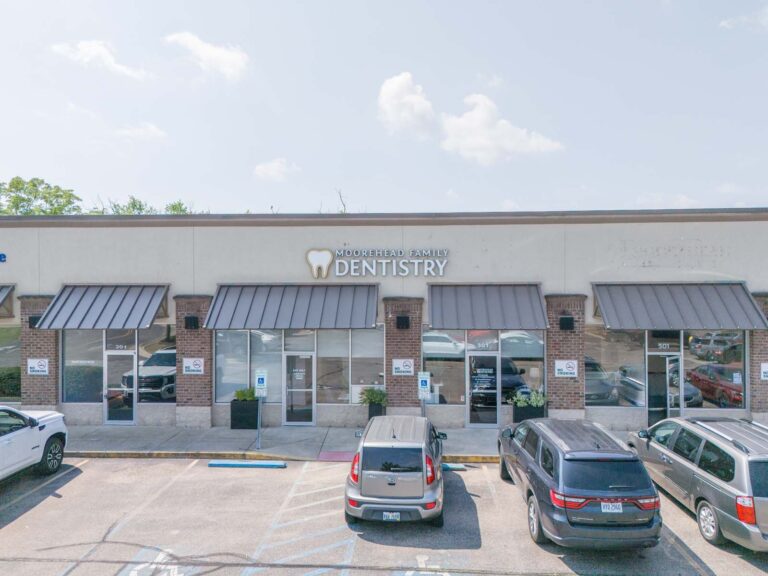What is Dental Technology?
High-End Dentistry at Moorehead Dentistry
When you visit the dentist, you may notice them using certain technology. These dental technologies can include anything from X-ray machines to CEREC® machines. All of the dental technology we use in-office helps streamline the process of visiting the dentist.
Types of Dental Technology
Digital X-rays
If you’ve ever visited a dentist before, you most likely have gotten x-rays taken. Digital X-rays are a standard practice at most dental offices. These digital X-rays save time and are safe for any patient.
Cone Beam Computed Technology (CBCT)
CBCT scanning allows our team to create images of your teeth, face, and neck with just one scan. These images are high-quality and help us gather detailed information to best diagnose every patient. The CBCT machine rotates once around your head while you stand or sit. It is a quick, simple, and painless process!
CEREC®
CEREC® stands for Chairside Economical Restoration of Esthetic Ceramic. CEREC® creates a state-of-the-art way of reconstructing tooth restorations. For patients who are in need of crowns, CEREC® makes it possible to walk out of the office with a new tooth in just one visit! This dental technology has revolutionized ceramic restorations so there is no waiting period preparing the restoration and receiving the final product.
Intraoral Camera
Intraoral cameras give our team a detailed view of your mouth in pictures and videos. This dental technology is useful for putting specific problem areas on the screen so we can see them in greater detail.
What Dental Technologies are Offered at Practice Name?
At Moorehead Dentistry, we offer dental technology to streamline our dental process as much as possible. We use the following technology in our practice:
- Digital X-rays
- Intraoral Camera
- CBCT
- 3D Printer
- Digital Photography
If you have any questions about dental technology, or what we use at our practice, please contact us and we will happily answer any of your questions.
Impacted Wisdom Teeth
What are Impacted Wisdom Teeth?
Impacted wisdom teeth are third molars at the back of the mouth that don’t have enough room to emerge or develop normally. Impacted wisdom teeth need to be removed as soon as possible so they do not cause problems in the future.
Wisdom teeth are the last adult teeth to erupt in the mouth. Most people have four wisdom teeth in the back of their mouth – two on the top and two on the bottom. Impacted wisdom teeth can result in pain, damage to the rest of your teeth, or other dental problems. In some cases, impacted wisdom teeth may cause no immediate problems. However, since they are hard to clean, they are more vulnerable to tooth decay and gum disease than the rest of your teeth.
Symptoms of Impacted Wisdom Teeth
Impacted wisdom teeth don’t always cause problems or symptoms. If the tooth is infected, damages other teeth, or causes other problems, you could experience these symptoms:
- Red or swollen gums
- Tender or bleeding gums
- Jaw pain
- Swelling around the jaw
- Bad breath
- An unpleasant taste in your mouth
- Difficulty opening your mouth
When to See a Doctor
If you are experiencing any symptoms behind your last molar, you should see a dentist as soon as possible as it can be associated with an impacted wisdom tooth.
Impacted wisdom teeth can become a serious problem so it is best to see a dentist before it causes issues. Learn more about wisdom teeth removal at Moorehead Dentistry by clicking the button below.
Wisdom Teeth RemovalWhat Issues Can Invisalign® Fix?
Enhance Your Smile with Invisalign®: A Comprehensive Guide
Invisalign® has transformed the landscape of orthodontic treatment, providing a discreet and comfortable alternative to traditional braces. The clear aligner system enables individuals to improve their smiles without the discomfort often associated with braces. While Invisalign® offers an aesthetically pleasing solution, it’s crucial to consider various factors when choosing orthodontic treatment. Our dentists at Moorehead Dentistry recommend evaluating your situation before making a decision. In this guide, we’ll explore the effectiveness of Invisalign® in addressing specific orthodontic issues.
Invisalign® Treatment for Common Concerns
1. Crooked Teeth
Invisalign® excels in treating crooked teeth, offering a practical solution to align teeth and enhance your smile discreetly.
2. Overbite & Underbite
Addressing both overbites and underbites, Invisalign® can reposition either the top or bottom teeth to achieve proper alignment with the mouth closed.
3. Crossbite
Invisalign® effectively corrects crossbites, ensuring that teeth align correctly when the mouth is closed, preventing misalignments in the back or front teeth.
4. Gaps in Teeth & Crowded Teeth
Whether you have gaps between your teeth or experience crowding, Invisalign® is a versatile solution. It resolves gaps and overcrowding, promoting optimal oral health.
Considerations and Limitations
While Invisalign® is an excellent option for various orthodontic issues, it’s essential to acknowledge its limitations. In some cases, traditional braces may be more suitable, especially for severe orthodontic problems, intrusion, and extrusion. It’s worth noting that Invisalign® has evolved over the years, now capable of addressing more complex situations than before.
To determine if Invisalign® is the right choice for you, we recommend consulting with our experts at one of our three Moorehead Dentistry locations. Contact one of our offices today for personalized guidance on achieving your ideal smile.
Learn More About Invisalign®



